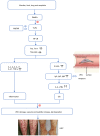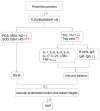Proanthocyanidins: A novel approach to Henoch‑Schonlein purpura through balancing immunity and arresting oxidative stress via TLR4/MyD88/NF‑κB signaling pathway (Review)
- PMID: 37229322
- PMCID: PMC10203752
- DOI: 10.3892/etm.2023.11999
Proanthocyanidins: A novel approach to Henoch‑Schonlein purpura through balancing immunity and arresting oxidative stress via TLR4/MyD88/NF‑κB signaling pathway (Review)
Abstract
Henoch-Schonlein purpura (HSP), a recurrent and immunoglobulin (Ig)A-mediated vasculitis, presents not only as skin lesions but also as systemic involvement that can be life-threatening. Although the etiology of HSP remains unknown, immune imbalance and oxidative stress (OS) are primary contributors to its pathogenesis, alongside the abnormal activation of Toll-like receptor (TLR)/myeloid differentiation primary response gene 88 (MyD88)/nuclear factor-κB (NF-κB) pathway. TLRs, especially TLR4, stimulate downstream signaling molecules such as NF-κB and proinflammatory cytokines, which are released when TLRs combine with the key adapter molecule MyD88. This leads to the activation of T helper (Th) cell 2/Th17 and overproduction of reactive oxygen species (ROS). The function of regulatory T (Treg) cells is suppressed in the process. Th17/Treg imbalance then produces various inflammatory cytokines to promote proliferation and differentiation of B cells and the secretion of antibodies. IgA is secreted, and it binds to vascular endothelial surface receptors where the complex induces injury of the vascular endothelial cells. Additionally, excessive ROS creates OS that leads to an inflammatory response and vascular cell apoptosis or necrosis, thereby contributing to vascular endothelial damage and HSP occurrence. Proanthocyanidins are active compounds naturally enriched in fruits, vegetables and plants. Proanthocyanidins have diverse properties, including anti-inflammatory, antioxidant, antibacterial, immunoregulatory, anticarcinogenic and vascular protective effects. Proanthocyanidins are used in the management of various diseases. Proanthocyanidins regulate T cells, equilibrate immunity and arrest OS by inhibiting the TLR4/MyD88/NF-κB signaling pathway. Considering the pathogenesis of HSP and the properties of proanthocyanidins, the present study hypothesized that these compounds may potentially lead to HSP recovery through modulating the immune equilibrium and preventing OS by inhibiting the TLR4/MyD88/NF-κB pathway. To the best of our knowledge, however, little is known about the positive effects of proanthocyanidins against HSP. The present review summarizes the potential of proanthocyanidins to treat HSP.
Keywords: Henoch-Schonlein purpura; immune imbalance; oxidative stress; proanthocyanidin.
Copyright: © Xie et al.
Conflict of interest statement
The authors declare that they have no competing interests.
Figures




Similar articles
-
Protection of Proanthocyanidins Against HSP Serum-Induced Inflammation and Oxidative Stress on Human Umbilical Vein Endothelial Cells.Clin Cosmet Investig Dermatol. 2024 Mar 23;17:731-743. doi: 10.2147/CCID.S440399. eCollection 2024. Clin Cosmet Investig Dermatol. 2024. PMID: 38550403 Free PMC article.
-
Proanthocyanidins alleviate Henoch-Schönlein purpura by mitigating inflammation and oxidative stress through regulation of the TLR4/MyD88/NF-κB pathway.Skin Res Technol. 2024 Sep;30(9):e13921. doi: 10.1111/srt.13921. Skin Res Technol. 2024. PMID: 39252568 Free PMC article.
-
Quercetin protects mouse liver against triptolide-induced hepatic injury by restoring Th17/Treg balance through Tim-3 and TLR4-MyD88-NF-κB pathway.Int Immunopharmacol. 2017 Dec;53:73-82. doi: 10.1016/j.intimp.2017.09.026. Epub 2017 Oct 15. Int Immunopharmacol. 2017. PMID: 29040945
-
Proanthocyanidins: novel treatment for psoriasis that reduces oxidative stress and modulates Th17 and Treg cells.Redox Rep. 2018 Dec;23(1):130-135. doi: 10.1080/13510002.2018.1462027. Redox Rep. 2018. PMID: 29630472 Free PMC article. Review.
-
Regulation of Toll-Like Receptor (TLR) Signaling Pathway by Polyphenols in the Treatment of Age-Linked Neurodegenerative Diseases: Focus on TLR4 Signaling.Front Immunol. 2019 May 10;10:1000. doi: 10.3389/fimmu.2019.01000. eCollection 2019. Front Immunol. 2019. PMID: 31134076 Free PMC article. Review.
Cited by
-
Association of TRPV1 and the SIRT3/SOD2 Signaling Pathway in Mononuclear Cells and Astrocyte-Derived Extracellular Vesicles in Patients with Schizophrenia.Brain Sci. 2025 Mar 25;15(4):339. doi: 10.3390/brainsci15040339. Brain Sci. 2025. PMID: 40309794 Free PMC article.
-
USP7 Stabilizes USF1 to Aggravate ox-LDL-Induced Endothelial Injury Through the MYD88/NF-κB Pathway in Atherosclerosis.Appl Biochem Biotechnol. 2025 Jul 18. doi: 10.1007/s12010-025-05312-2. Online ahead of print. Appl Biochem Biotechnol. 2025. PMID: 40679551
-
Antioxidant and Anti-Apoptotic Neuroprotective Effects of Cinnamon in Imiquimod-Induced Lupus.Antioxidants (Basel). 2024 Jul 22;13(7):880. doi: 10.3390/antiox13070880. Antioxidants (Basel). 2024. PMID: 39061948 Free PMC article.
-
Protection of Proanthocyanidins Against HSP Serum-Induced Inflammation and Oxidative Stress on Human Umbilical Vein Endothelial Cells.Clin Cosmet Investig Dermatol. 2024 Mar 23;17:731-743. doi: 10.2147/CCID.S440399. eCollection 2024. Clin Cosmet Investig Dermatol. 2024. PMID: 38550403 Free PMC article.
-
BMSC-derived exosomes regulate the Treg/Th17 balance through the miR-21-5p/TLR4/MyD88/NF-κB pathway to alleviate dry eye symptoms in mice.In Vitro Cell Dev Biol Anim. 2024 Jun;60(6):644-656. doi: 10.1007/s11626-024-00910-6. Epub 2024 Apr 29. In Vitro Cell Dev Biol Anim. 2024. PMID: 38684579
References
-
- Chimenz R, Cannavò L, Spinuzza A, Fede C, Cucinotta U, Pensabene L, Betta P, Gitto E, Concolino D, Cuppari C. Unusual presentation of Henoch-Schönlein purpura. J Biol Regul Homeost Agents. 2019;33 (5 Suppl 1):S69–S74. - PubMed
-
- Gómez S, Pérez M, Pellegrini M, Isern E, Quintana C, Artacho P, Bertolini M, Pomerantz B, Gadda N. Henoch-Schonlein purpura in pediatrics: Ten years of experience at a moderate risk office of a general hospital. Arch Argent Pediatr. 2020;118:31–37. doi: 10.5546/aap.2020.eng.31. (In English, Spanish) - DOI - PubMed
-
- Zhu Y, Dong Y, Wu L, Deng F. Changes of inflammatory mediators and oxidative stress indicators in children with Henoch-Schönlein purpura and clinical effects of hemoperfusion in the treatment of severe Henoch-Schönlein purpura with gastrointestinal involvement in children. BMC Pediatr. 2019;19(409) doi: 10.1186/s12887-019-1802-2. - DOI - PMC - PubMed
Publication types
LinkOut - more resources
Full Text Sources
Miscellaneous
